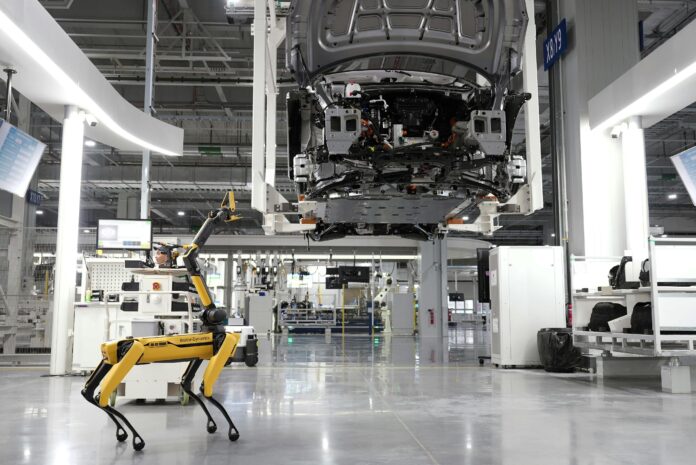Introduction: A New Industrial Renaissance
Since the first steam engines of the Industrial Revolution, humanity has constantly sought ways to make production faster, safer, and more efficient. Today, robotics and automation have become the defining forces of the Fourth Industrial Revolution (Industry 4.0), transforming how we manufacture, distribute, and deliver products and services.
The impact of robotics and automation on industry reaches far beyond factory walls—it reshapes employment, business competitiveness, and the very nature of innovation. While early automation once raised fears of job loss, history shows that technological progress ultimately drives economic growth, creates new opportunities, and enhances quality of life.
The Global Rise of Robotics and Automation
The global automation market has entered a period of unprecedented growth. According to the International Federation of Robotics (IFR), more than 517,000 industrial robots were installed worldwide in 2021—a 31 percent increase from the previous year. The top adopters—China, Japan, the United States, Korea, and Germany—account for nearly 78 percent of all installations.
This acceleration was amplified by the COVID-19 pandemic, which exposed vulnerabilities in manual labor–dependent supply chains and pushed companies to adopt automation for continuity and resilience.
In developing regions such as Vietnam and Algeria, robotics is no longer a distant concept. Local manufacturers and startups are integrating robotic systems to compete globally. For instance, EMTEK Automation (Vietnam) collaborates with electronics giants like Samsung and LG to design automated machines and robotic systems that optimize assembly lines, improve testing accuracy, and cut resource waste. These examples highlight that automation is democratizing technology—allowing emerging economies to leapfrog into advanced manufacturing.
Key Drivers Behind Industrial Automation
Three converging trends explain why automation has become central to modern industry:
- Technological Maturity: Robots are smaller, smarter, and cheaper than ever before. Collaborative robots (cobots) can safely work beside humans without cages or barriers.
- Artificial Intelligence Integration: AI enables robots to “see,” “learn,” and “adapt,” turning automation from rigid programming into flexible, self-optimizing systems.
- Global Labor Dynamics: Chronic labor shortages—especially in manufacturing—have forced companies to automate repetitive, hazardous, or undesirable jobs.
In the U.S., over 750,000 manufacturing positions were unfilled in 2023, and this number could reach 2.1 million by 2030 (Deloitte). Automation is not eliminating work; it is redefining it.
The Benefits of Robotics and Automation in Industry
1. Enhanced Production Efficiency
Industrial robots perform repetitive tasks with unmatched speed and precision. Companies like SDC Engineering have achieved throughput increases of up to 500 percent by deploying automated machinery. In Algeria’s building-materials sector, research shows that factories using robots outperform those relying solely on human labor in nearly every productivity measure.
2. Improved Quality and Precision
Automation minimizes human error and ensures consistent results. From automotive welding to micro-assembly of medical devices—such as Cretex Medical’s use of the Meca500 micro-robot for catheter production—automation ensures superior accuracy and reproducibility. Higher product quality strengthens brand trust and reduces waste, benefiting both consumers and manufacturers.
3. Reduced Operational Costs
Although the initial investment in robotics can be high, long-term savings are substantial. Robots work 24 hours a day, require minimal maintenance, and reduce production downtime. Over time, lower defect rates and faster output offset capital expenditures, delivering sustainable profitability.
4. Safer and Healthier Work Environments
Robots can handle dangerous, repetitive, or ergonomically stressful tasks—welding, heavy lifting, chemical processing—allowing human workers to focus on supervision, maintenance, and creative problem-solving. This not only reduces occupational hazards but also enhances overall job satisfaction and safety compliance.
5. Flexibility and Scalability
Modern robotic systems are reprogrammable and modular. A single robot can be quickly adapted for multiple tasks—from packaging to inspection—without extensive downtime. This flexibility is critical for small and medium-sized enterprises (SMEs) facing dynamic customer demand.
6. Supply-Chain Optimization
Automation reduces bottlenecks and accelerates order fulfillment. Smart robots integrated with AI and IoT technologies can coordinate seamlessly with logistics software, shortening supply-chain cycle time and improving responsiveness to market fluctuations.
7. Labor Cost Reduction and Reallocation
By handling repetitive operations, automation reduces reliance on manual labor. Yet, instead of causing unemployment, it often redirects workers toward higher-value tasks such as programming, robotics maintenance, quality assurance, and data analytics. This shift supports the rise of knowledge-based manufacturing economies.
8. Environmental and Resource Efficiency
Automation enables precise control over energy use and material consumption. Smart robots can monitor performance, detect inefficiencies, and reduce waste, contributing to sustainability and environmental goals—key metrics in modern ESG strategies.
The Human Dimension: Jobs, Skills, and Adaptation
A central theme across all analyses of the impact of robotics and automation on industry is the changing relationship between humans and machines. The World Economic Forum estimates that automation could displace 85 million jobs by 2025 but simultaneously create 97 million new ones in technology, analytics, and services. The OECD predicts that 1.1 billion workers will require reskilling by 2030.
The challenge is not technological—it is educational and social. Governments, universities, and corporations must invest in reskilling and upskilling programs to help workers transition into the new digital economy. If managed properly, the World Economic Forum projects that reskilling could add $6.5 trillion to global GDP by 2030.
Collaborative robots demonstrate this balance vividly: cobots do not replace workers but augment them, performing precision or strength-intensive tasks while people handle decision-making and creative roles. The result is a safer, smarter, and more inclusive workplace.
Regional Innovations: The Case of EMTEK Automation in Vietnam
EMTEK’s story exemplifies how local enterprises in emerging markets are leveraging robotics to climb the global value chain.
Founded in 2016, EMTEK Automation offers turnkey solutions, including robot programming, machine design, and automated production line installation. Its flagship products, such as the C-Flip Machine and TC-Aging Screen Testing Machine, have streamlined assembly operations for electronics manufacturers.
By combining advanced control systems (ACS) with robotic grippers and vision technologies, EMTEK helps factories achieve higher yields, reduced defect rates, and faster adaptation to new product lines. Such innovation demonstrates that automation is not confined to industrialized nations; it is becoming a cornerstone of regional industrial modernization.
Challenges and Considerations
Despite its advantages, automation brings real challenges that industries must address:
- Initial Capital Investment: High setup costs can deter smaller companies without access to financing.
- Workforce Displacement Anxiety: Without clear communication and training, employees may perceive automation as a threat.
- Cybersecurity Risks: As factories become hyper-connected, protecting data and operational systems becomes critical.
- Ethical and Regulatory Frameworks: Governments need policies to ensure equitable growth, data privacy, and worker welfare.
Successfully navigating these challenges requires strategic planning, transparent governance, and international cooperation.
The Future Outlook: Toward Intelligent, Sustainable Industry
Looking ahead, automation will move beyond mechanical repetition toward intelligent autonomy. Integration of AI, machine learning, and cloud robotics will allow machines to self-diagnose issues, predict maintenance, and optimize performance without human intervention.
Sectors like healthcare, logistics, agriculture, and energy are already seeing benefits from robotic precision—from automated surgeries to smart farming drones.
Research from the McKinsey Global Institute estimates that automation could boost global productivity growth by 0.8 to 1.4 percent annually by 2030. This means higher output, lower costs, and improved access to essential goods worldwide.
In the developing world, the adoption of robotics can bridge industrial gaps by empowering local companies to meet global standards. Governments encouraging partnerships between universities, startups, and manufacturers—as seen in Algeria’s innovation policies and Vietnam’s private-sector initiatives—are building ecosystems where entrepreneurship and automation reinforce each other.
Conclusion: Embracing the Human-Machine Partnership
The impact of robotics and automation on industry is both profound and irreversible. Far from making humans obsolete, automation is pushing society toward a more innovative, productive, and sustainable future.
From advanced manufacturing lines to precision medicine and green energy, robotics enhances every sector it touches. The challenge ahead is ensuring that this technological progress translates into inclusive prosperity.
History shows that every industrial revolution has created more opportunities than it destroyed. By investing in education, digital infrastructure, and responsible innovation, we can ensure that robotics becomes not a replacement for human effort but an extension of human potential—the ultimate partnership between intelligence, creativity, and technology.
Check Also:


